The Anker Solix C300 and EcoFlow River 3 are two compact power stations with a range of attractive features. Either one could easily be your next essential gadget, keeping small devices charged and powered up whenever and wherever you want.
Yet you don’t want to get just any option. You want to know which one is better for your needs and provides a better value. And this article has the real information you need to make that choice, along with the details to truly understand what these are capable of powering.
Let’s see which power station comes out on top: the Anker Solix C300 or the EcoFlow River 3.
We carefully select the products and services we link to. If you buy through our links, we may earn a commission. There’s no extra cost to you and it helps us provide this information.

Power and Portability: Quick Overview
These two options come from two of the best brands you can find. Anker’s long line of battery-focused devices meets EcoFlow’s power station prowess. Both the Anker C300 and River 3 are newly-released options that have pushed the limits of small power stations forward, offering a more compact size and even lower price.
We’ve scrutinized these with our expert analysis. Although both are very attractive options, the Anker C300 comes out slightly ahead of the EcoFlow River 3. However, the differences are marginal and you really can’t go wrong with either option.
The Anker Solix C300 has the advantage with these well-rounded features:
- Larger battery capacity
- Extra USB-C ports and AC outlet with faster UPS time
- Longer 5-year warranty

We don’t think the EcoFlow River 3 should be ignored. It’s remarkably similar and holds its own with a few standout features:
- Compact, lightweight design that stacks easier
- Special X-Boost feature for power-hungry devices
- Slightly faster solar charging
When it comes to value, you can’t beat these two. Not only are the MSRPs low, but they’re incredible when looked at as a cost per battery watt-hour (an even standard to judge power station value). Without any discount, they’re both under $1.00 per Wh. And sometimes you can get them for much lower, especially if you use Solar Waypoint’s discount codes.
And if you want to save the most money, check out the Anker C300 DC. It drops the price even lower by leaving off the inverter. It delivers maximum value without the AC outlets.
In the end, the larger battery, extra connections, and longer warranty make the Anker Solix C300 the better choice for most people. Yet the EcoFlow River 3 still has plenty of battery and connections, plus a design shape we prefer. Both of these power stations offer great performance for their price, so the choice might come down to the current sales or discounts you can get.
Get 15% off most Anker Solix orders with ANKERSOLARWAY discount code.
Get 5% off most EcoFlow orders with SOLARWAY5OFF discount code.

|
Anker Solix C300 |
C300 on Anker C300 on Amazon |

|
EcoFlow RIVER 3 |
R3 on EcoFlow R3 on Amazon |
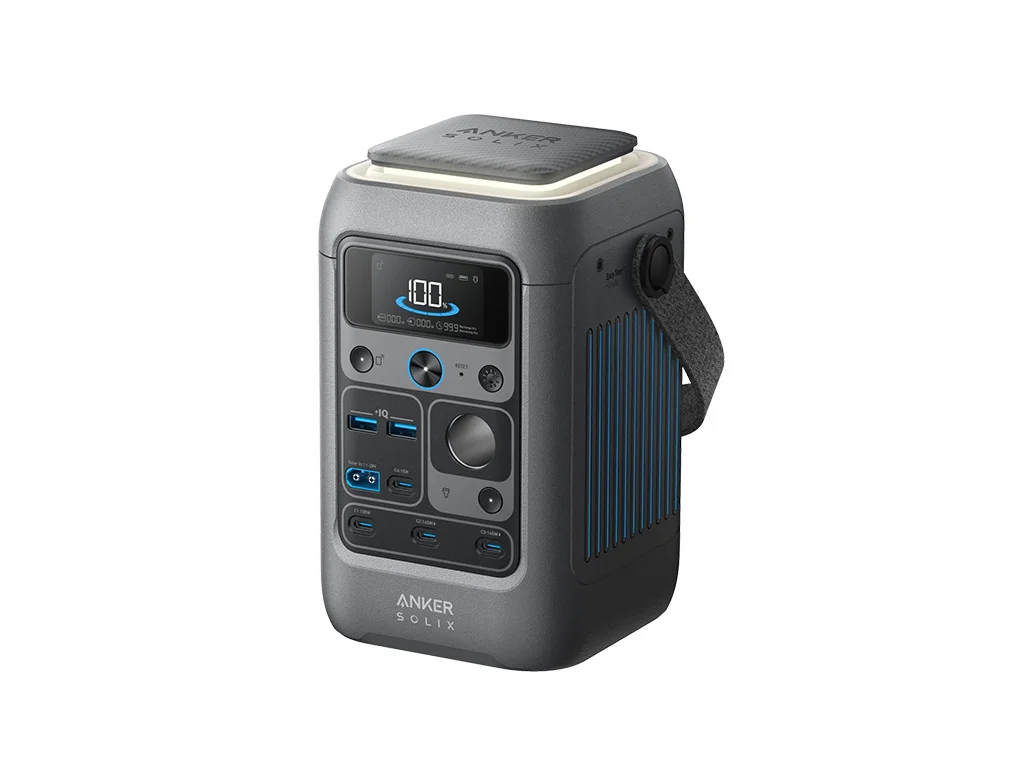
|
Anker Solix C300 DC |
300 DC on Anker 300 DC on Amazon |
A Battle of Portable Power: Anker Solix C300 vs. EcoFlow River 3
These portable power stations are two of the best compact options. To help you decide which is right for your needs, we’ve broken down the most important features and specs into bite-sized chunks.
Here’s how we’ll compare these two powerhouses:
- What Can These Power? Inverter and Outputs
- How Long Do They Last? Battery Details
- How Fast Do They Recharge? Charging Inputs
- Which Has a Better Design? Size and Portability
- What’s the Best Pick? Final Verdict

Plugging Into Power: Outlets, Inverters, and What They Can Handle
When it comes to portable power stations, the inverter and the variety of outputs determine what devices you can power or charge. Both the Anker Solix C300 and the EcoFlow River 3 offer flexible options, but how do they stack up against each other?
An inverter’s job is to convert the stored DC (direct current) power from the battery into usable AC (alternating current) power, the same kind that comes out of your home’s outlets. Why does inverter size matter? Well, the larger the inverter, the bigger the devices it can power. Let’s break it down.
Both the Anker C300 and the River 3 come with 300W inverters, meaning they can handle a range of low- to medium-powered devices. However, the River 3 comes with EcoFlow’s X-Boost feature, which allows it to power some devices up to 600W. It lowers the voltage to do so.
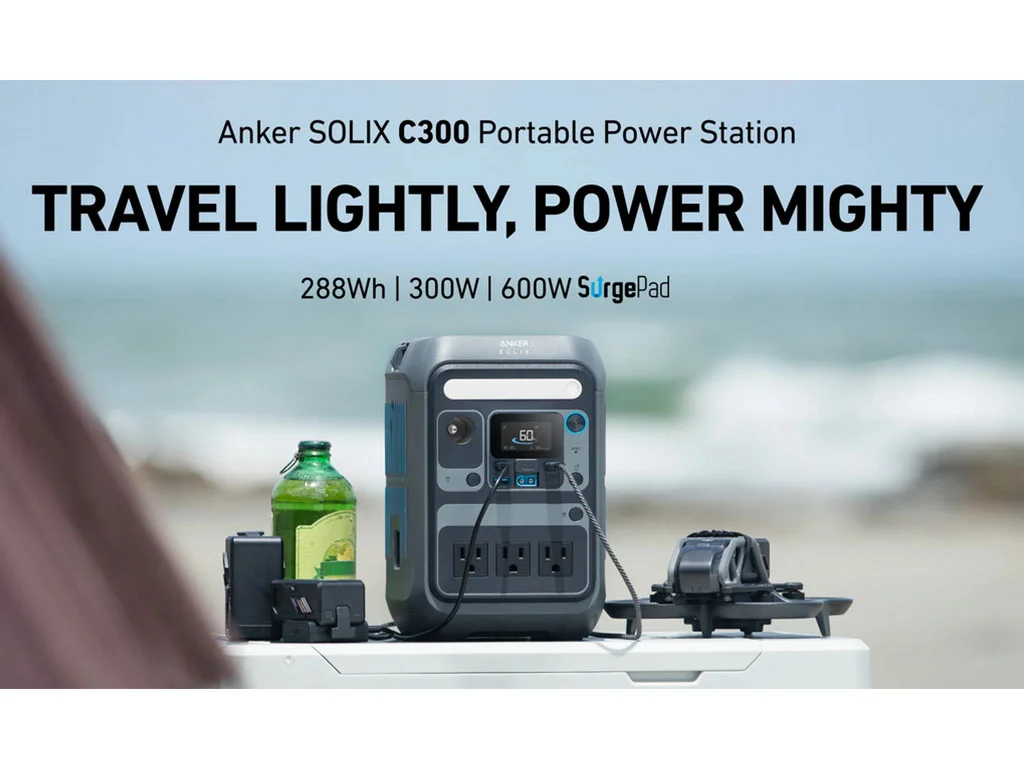
Here’s what that 300W inverter power means in reality:
- Low watt (30W or less): Phones, tablets, small batteries (e.g., GoPro or camera batteries); Both units handle these easily via USB ports.
- Medium watt (30W to 80W): Laptops, portable fridges; Both units have no problem here either, usually through USB-C ports for laptops and the 12V car port for portable fridges. Sometimes these devices require AC outlets though.
- High watt (100W to 300W): Desktop computers, larger fridges; You’ll need to use the AC outlets for these, and as long as they’re 300W or less, either option works.
While both power stations do a solid job with devices under 300W, they won’t cut it for anything bigger like a full-size fridge or space heater. Even EcoFlow’s 600W X-Boost has some limits for devices that can’t use lower voltages. The battery life is also critical to consider, which we’ll cover in the next section.

To use these power stations to keep your computer or another critical device powered up through a grid outage, the seamless UPS (uninterruptible power supply) feature is what will step in. When plugged in to a wall outlet during a blackout, the UPS transfer time determines how quickly it will switch to internal battery power. And Anker is better:
- Anker C300: Near-instant transfer time of 10 milliseconds or less.
- EcoFlow River 3: Slightly slower transfer time of 20 ms, which may be fast enough or it may cause a brief flicker in power for sensitive electronics.
If you don’t need AC outlets at all, the Anker Solix C300 DC offers all the same features, minus the inverter and for a lower price. It also adds an extra USB-C port for more charging flexibility and a bigger pop-up lantern on top.
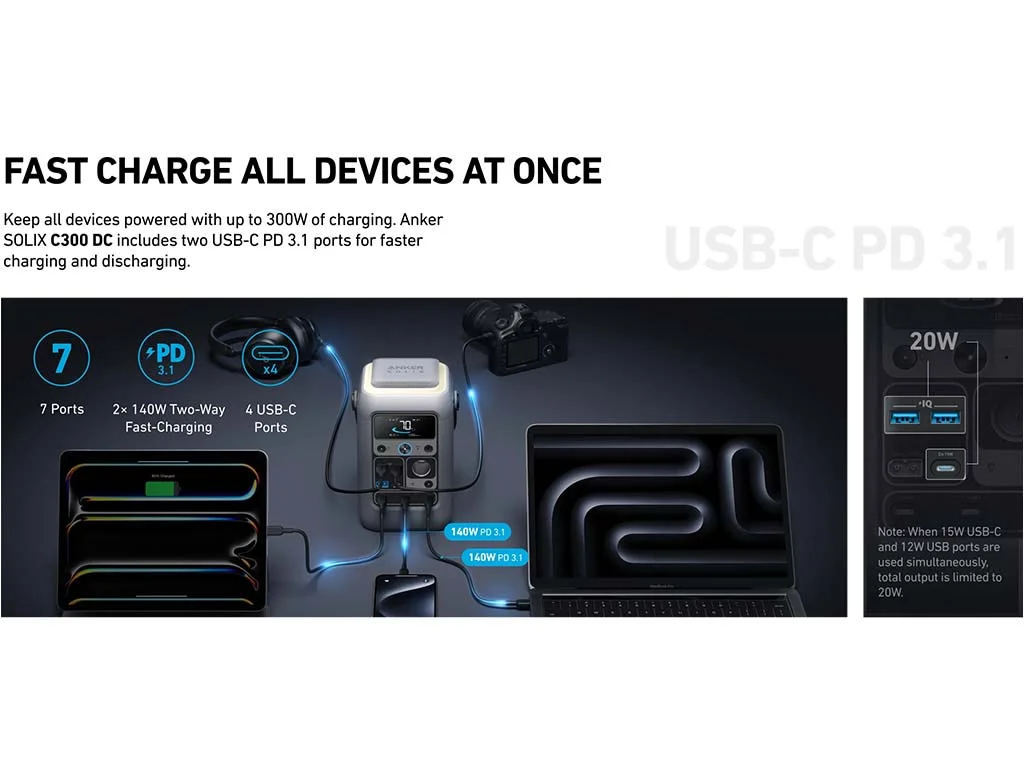
Both units provide an array of output option. And here’s a precise comparison of the connections:
- Standard AC outlets: Three on the C300 and only two on the River 3.
- USB-A: One on the C300 and two on the River 3.
- USB-C ports: Three on the C300 (four on the C300 DC) and only one on the River 3.
- 12V car ports: One on both
The USB-C ports on the Anker Solix C300 are incredible. No other brand has this many. Even the 3 AC outlets are far beyond what others include.
Output Verdict: The power inverters are nearly identical at 300W, although the 600W X-Boost on the EcoFlow can be useful for compatible devices. Yet when it comes to UPS transfer time and the sheer amount of connections, the Anker Solix C300 is the clear winner. It has more outlets and an impressive amount of USB-C ports, which are especially useful for high-powered devices like laptops. The C300 DC is the choice if you don’t need AC outlets but want an extra USB-C port.
| Product | EcoFlow RIVER 3 | Anker Solix C300 | Anker Solix C300 DC |
|---|---|---|---|
| AC Output | 300W | 300W | – |
| AC Output Peak | 600W | 600W | – |
| 120V Outlets | 2 | 3×2.5A | – |
| UPS / EPS | 20ms | 10ms | – |
| USB-A Ports | 2x12W | 1x12W | 1x12W |
| USB-C Ports | 1x100W | 1x15W, 2x140W | 1x15W, 1x100W, 2x140W |
| Cigarette Lighter | 1x126W | 1x120W | 1x120W |
| Connectivity | WiFi / Bluetooth | WiFi / Bluetooth | WiFi / Bluetooth |

Power That Lasts: Battery Capacity and Real-World Usage
To know how long any power station can run your devices, the battery capacity is everything. Measured in watt-hours (Wh), it tells you how much energy the unit can store.
The Anker Solix C300 boasts a 288Wh battery, while the EcoFlow River 3 comes in slightly lower at 245Wh. That’s about 15% lower.
The Solix C300 can charge a 10Wh phone about 23 times while the EcoFlow knocks that down to 19. For a 30Wh tablet battery, it’s nearly 8 times against 6.5. The Anker can charge a 60Wh laptop for about 3.8 times, while the River 3 is about 3.25.
Overall, these are very similar batteries. There’s no doubt the Anker option holds more power, but it’s unlikely to make a major difference in how you can truly use these compact power stations. Either one will do great for charging phones, tablets, and running small LED lights. They’ll handle a handful of laptop charges or an hour or so running a 200W TV.
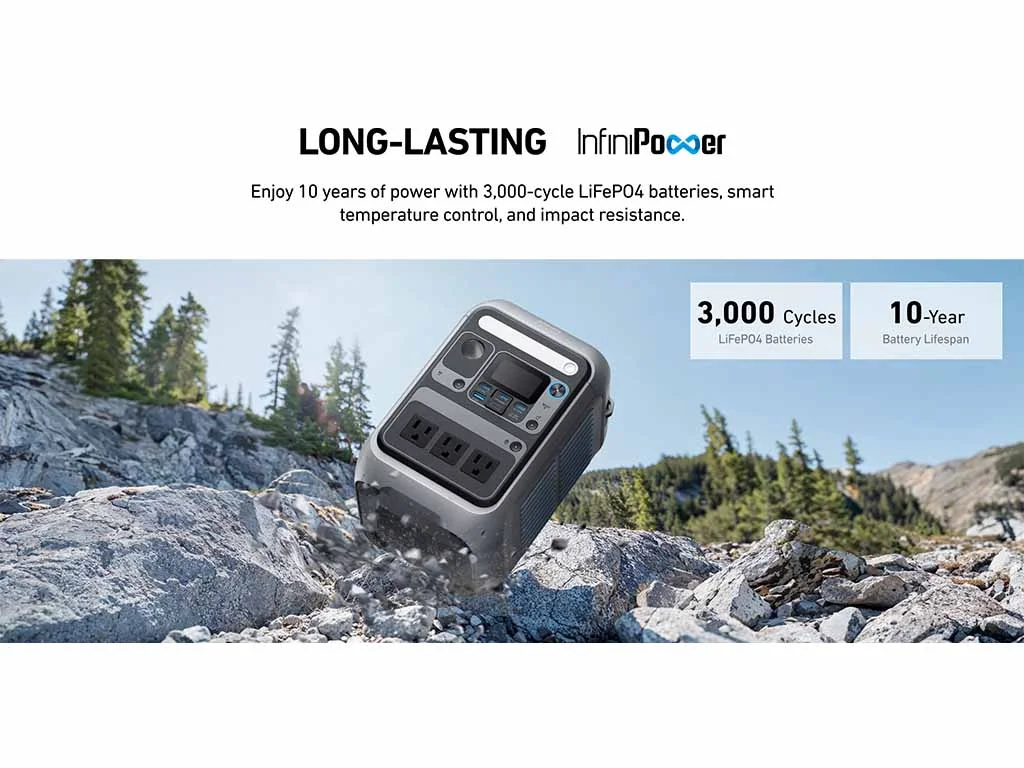
Try to power a 40W fridge of CPAP overnight and you’ll be disappointed. You need a bigger battery for that. 40W is less than 6 hours of runtime on the Anker and less than 5 on the EcoFlow. This is often a complaint about the smallest power stations; it’s not easy to understand their limits without this information. But if you want 8 to 10 hours or more of runtime for a CPAP or portable fridge, you need a larger power station. Don’t waste your money on a power station that can’t meet your needs. Head over to the EcoFlow DELTA 3 Plus vs. Anker Solix C1000 comparison instead.
You’ll find long-lasting LiFePO4 (LFP) batteries, rated for over 3,000 charge cycles, in both of these units. That’s roughly 8 years of daily use before the battery degrades to 80% capacity. As for warranties, the Solix C300 pulls ahead with an impressive 5-year warranty, compared to the River 3’s 2-year coverage.
Battery Verdict: The Anker Solix C300 edges out the EcoFlow River 3 in battery capacity, offering a bit more juice although the practical difference isn’t so serious. However, the Anker comes with a much longer 5-year warranty compared to EcoFlow’s 2-year coverage. The River 3 still holds its own with solid real-world performance for most users’ needs and a battery that should outlast the warranty coverage.
| Product | EcoFlow RIVER 3 | Anker Solix C300 |
|---|---|---|
| Battery | 245Wh | 288Wh |
| Warranty | 2 years | 5 years |
| Battery Type | LiFePO4 / LFP | LiFePO4 / LFP |
| Battery Cycles | >3,000 | >3,000 |
| Buy Now | Buy R3 | Buy Now |
| Buy on Amazon | Buy on Amazon | C300 on Amazon |
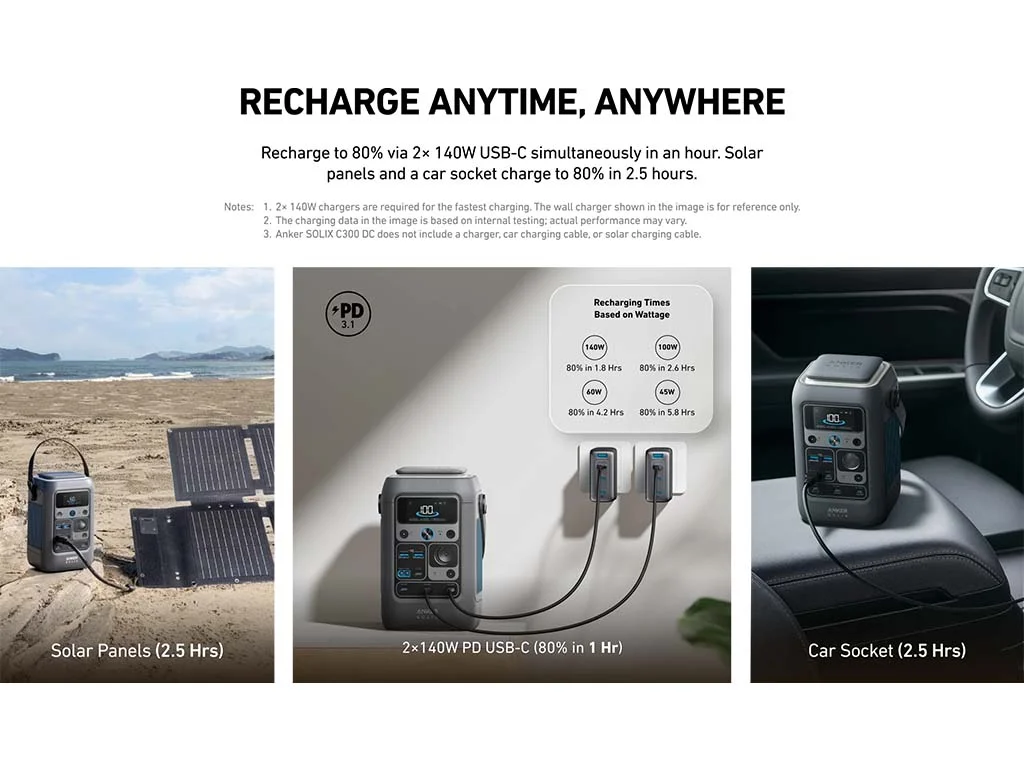
Fast and Flexible: Charging Speeds and Inputs
The ability to quickly recharge your portable power station can be crucial. And these two both have super-fast capabilities that you’ll never have to worry about. Plug it in while you’re packing or as soon as you see the sky turn dark and you’ll have a full power station within an hour or so.
When it comes to solar charging, the higher the input wattage, the quicker your power station fills up. These are very similar with 100W solar for the Anker and 110W for the EcoFlow, charging in about 3 to 3.5 hours. This difference isn’t worth basing your decision on. It looks so much shorter on the EcoFlow because it has a smaller battery, not because the extra 10W is so crucial.
Both units also allow car charging for added flexibility. A standard car 12V cigarette lighter port provides 120W, so it’s similar to solar charging. And a great way to make sure you have power no matter where you drive.
Charging Verdict: This section is a tie with fast charging options all around. AC charging from a wall outlet is very fast on both units, while solar and car charging are sufficiently fast for most needs.
| Product | EcoFlow RIVER 3 | Anker Solix C300 |
|---|---|---|
| AC Input | 320W | 330W |
| AC Recharge Hours (Est.) | 0.9h | 1h |
| Solar Input | 110W | 100W |
| Solar Recharge Hours (Est.) | 2.7h | 3.5h |
| Solar Input 1 Watts | 110W | 100W |
| Solar Input 1 Volts Min | 11V | 11V |
| Solar Input 1 Volts Max | 30V | 28V |
| Solar Input 1 Amps | 8A | 8.2A |

How Portable Are They? Size and Weight Breakdown
One of the biggest advantages of a portable power station is – you guessed it – portability. Unlike DIY solar setups or large backup systems, these compact units can go wherever you need them.
The Anker Solix C300 weighs in at 9.1 pounds (4.1 kg), making it slightly bulkier than the EcoFlow River 3 at 7.8 pounds (3.5 kg).
While both units are very light, we prefer the flatter shape of the River 3. You can put it on your desk or in a storage space and stack things on it. The Anker has a smaller footprint but taller shape. This comes down to personal preference.
If weight is a major concern, the Anker C300 DC (without the inverter) drops down to 6.2 pounds (2.8 kg). You can’t find a lighter power station.
Portability Verdict: The EcoFlow River 3 takes the win for portability with its lighter weight and smaller size, making it ideal for frequent travelers or those with limited space. The Anker Solix C300 is still a very compact option, although we prefer the shape of the River 3 so you can put things on top easier.
| Product | EcoFlow RIVER 3 | Anker Solix C300 |
|---|---|---|
| Weight (lbs) | 7.8lbs | 9.1lbs |
| Weight (kg) | 3.5kg | 4.1kg |
| Dimensions (in) | 10×8.3×4.4in | 6.5×6.3×9.5in |
| Dimensions (mm) | 254x211x112mm | 164x161x240mm |
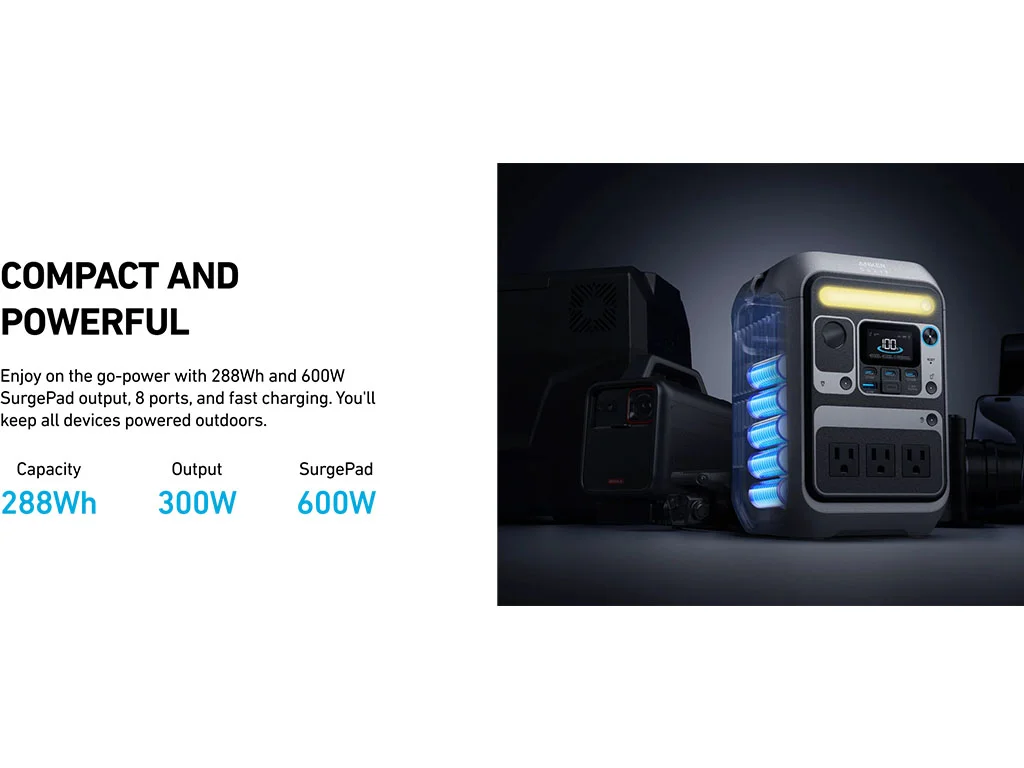
Our Final Verdict: Which to Choose?
After comparing the Anker Solix C300 and EcoFlow River 3 across key factors, both power stations have their strengths and are amazing options compared to the industry as a whole. You’re looking at two very similar and very capable compact power stations.
However, the Anker C300 is better than the River 3 in many ways. It has a larger battery, longer warranty, and it has an industry-leading number of outlets and ports. And if you don’t need the AC outlets, you can save even more money by going with the C300 DC.
We like a lot of things about the EcoFlow River 3 and it’s still a great choice for powering small devices anywhere. Its X-Boost feature to boost up to 600W is the main advantage over the C300. The shorter warranty is our least favorite aspect, but the River 3 price with discounts can often make that seem trivial. And it’s still a very similar device with almost identical practical usage.
| Anker C300 | EcoFlow River 3 |
|---|---|
Here’s a recap of the key features:
- Inverter and Outputs: The Solix C300 wins with more output options and faster UPS function, but the River 3’s X-Boost feature adds flexibility for powering higher-watt devices.
- Battery Capacity: The Solix C300 has a larger battery, which means more runtime for your devices, making it the better option for longer use.
- Charging Speeds: Both have very fast chagrin options for home outlets, solar panels, and car charging.
- Portability: The River 3 is lighter with a wider design we like for its stack-ability. Yet the C300 is still very small and compact, with the C300 DC being the lightest of all.
- Value: Both have incredible prices, especially when looked at on a price per Wh basis. When you factor in discounts, you’ll be hard pressed to find a better value.
Final Recommendation: The Anker Solix C300 is our choice in this power station comparison. It has more connections, a larger battery, and a longer warranty, making it the more attractive choice if price is identical. The C300 DC is great if you don’t need the AC outlets. We still recommend the EcoFlow River 3 and its X-Boost technology and nearly identical lineup across the board, even if it’s slightly lagging the C300. In many ways, we suggest going with the one that meets your needs and has the lowest current price.
Get 15% off most Anker Solix orders with ANKERSOLARWAY discount code.
Get 5% off most EcoFlow orders with SOLARWAY5OFF discount code.

|
Anker Solix C300 |
C300 on Anker C300 on Amazon |

|
EcoFlow RIVER 3 |
R3 on EcoFlow R3 on Amazon |

|
Anker Solix C300 DC |
300 DC on Anker 300 DC on Amazon |

Side-by-Side Specs: Anker C300 vs. River 3 Comparison Chart
Check out the full specs of the Anker Solix C300 and the EcoFlow River 3 in this comprehensive comparison chart. You’ll also find links to the official user manuals if you still have any questions.
| Product | EcoFlow RIVER 3 | Anker Solix C300 | Anker Solix C300 DC |
|---|---|---|---|
| Battery | 245Wh | 288Wh | 288Wh |
| AC Output | 300W | 300W | – |
| AC Output Peak | 600W | 600W | – |
| AC X-Boost | 600W | – | – |
| AC Input | 320W | 330W | 140W |
| AC Recharge Hours (Est.) | 0.9h | 1h | 2.5h |
| Solar Input | 110W | 100W | 100W |
| Solar Recharge Hours (Est.) | 2.7h | 3.5h | 3.5h |
| Warranty | 2 years | 5 years | 3 years |
| Weight (lbs) | 7.8lbs | 9.1lbs | 6.2lbs |
| Weight (kg) | 3.5kg | 4.1kg | 2.8kg |
| Dimensions (in) | 10×8.3×4.4in | 6.5×6.3×9.5in | 4.9×4.7×7.9in |
| Dimensions (mm) | 254x211x112mm | 164x161x240mm | 124x120x200mm |
| Solar Input 1 Watts | 110W | 100W | 100W |
| Solar Input 1 Volts Min | 11V | 11V | 11V |
| Solar Input 1 Volts Max | 30V | 28V | 28V |
| Solar Input 1 Amps | 8A | 8.2A | 8.2A |
| Battery Type | LiFePO4 / LFP | LiFePO4 / LFP | LiFePO4 / LFP |
| Battery Cycles | >3,000 | >3,000 | >3,000 |
| 120V Outlets | 2 | 3×2.5A | – |
| UPS / EPS | 20ms | 10ms | – |
| USB-A Ports | 2x12W | 1x12W | 1x12W |
| USB-C Ports | 1x100W | 1x15W, 2x140W | 1x15W, 1x100W, 2x140W |
| Cigarette Lighter | 1x126W | 1x120W | 1x120W |
| Connectivity | WiFi / Bluetooth | WiFi / Bluetooth | WiFi / Bluetooth |
| User Manual | User Manual | User Manual | User Manual |
| Buy Now | Buy R3 | Buy Now | Buy Now |
| Buy on Amazon | Buy on Amazon | C300 on Amazon | C300 DC on Amazon |
Final Wrap Up
Both the Anker Solix C300 and the EcoFlow River 3 are incredible compact power stations we have no issues recommending. Yet the Anker C300 stands out with its larger battery, extra USB-C ports, and longer warranty. It’s a solid choice for users who need a little more power over a longer period.
However, the EcoFlow River 3 is still one of our favorite compact options and is a top-tier lightweight solution with fast charging and a sleek design.
Check out our detailed review of the Anker Solix C300 and deep dive into the EcoFlow River 3 for even more insights. Or learn about more power station comparisons:
Choose the right power station to stay connected, powered up, and ready for your next adventure. Get it now so you’re prepared for your portable power needs.







